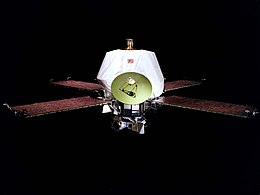 | |
| Mission type | Mars orbiter |
|---|---|
| Operator | NASA / JPL |
| COSPAR ID | 1971-051A |
| SATCAT no. | 5261 |
| Mission duration | 1 year, 4 months and 27 days[1] |
| Spacecraft properties | |
| Manufacturer | Jet Propulsion Laboratory |
| Launch mass | 997.9 kilograms (2,200 lb) [1] |
| Dry mass | 558.8 kilograms (1,232 lb) |
| Power | 500 watts |
| Start of mission | |
| Launch date | May 30, 1971, 22:23:04 UTC |
| Rocket | Atlas SLV-3C Centaur-D |
| Launch site | Cape Canaveral |
| End of mission | |
| Disposal | Decommissioned |
| Deactivated | October 27, 1972 |
| Decay date | c. October 2022 |
| Orbital parameters | |
| Reference system | Areocentric |
| Eccentricity | 0.6014 |
| Periareion altitude | 1,650 km (1,030 mi) |
| Apoareion altitude | 16,860 km (10,480 mi) |
| Inclination | 64.4 degrees |
| Period | 11.9 hours / 719.47 minutes |
| Epoch | 29 December 1971, 19:00:00 UTC[2] |
| Mars orbiter | |
| Orbital insertion | November 14, 1971, 00:42:00 UTC |
Mariner 9 (Mariner Mars '71 / Mariner-I) was a robotic spacecraft that contributed greatly to the exploration of Mars and was part of the NASA Mariner program. Mariner 9 was launched toward Mars on May 30, 1971,[2][3] from LC-36B at Cape Canaveral Air Force Station, Florida, and reached the planet on November 14 of the same year,[2][3] becoming the first spacecraft to orbit another planet[2] – only narrowly beating the Soviet probes Mars 2 (launched May 19) and Mars 3 (launched May 28), which both arrived at Mars only weeks later.
After the occurrence of dust storms on the planet for several months following its arrival, the orbiter managed to send back clear pictures of the surface. Mariner 9 successfully returned 7,329 images over the course of its mission, which concluded in October 1972.[4]
- ^ a b Cite error: The named reference
nasa1was invoked but never defined (see the help page). - ^ a b c d Cite error: The named reference
nssdc1was invoked but never defined (see the help page). - ^ a b Cite error: The named reference
final_reportwas invoked but never defined (see the help page). - ^ Cite error: The named reference
nasa2was invoked but never defined (see the help page).